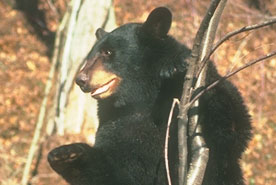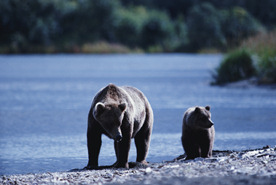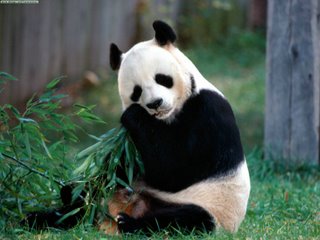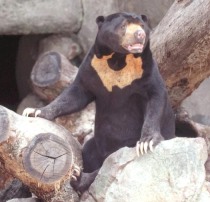Bears are large animals with small legs and stubby tails that can be found all over the World. Today eight bear species remain in North and South America, Europe, and Asia, but it is believed that at one time over 100 different species existed. It is important to learn about bears because they are becoming more and more endangered. Bears are magnificent creatures that all have unique and amazing characteristics that help them to survive. Make sure to take notes on each of the species of bears because next week we will learn about the other three species. These notes will help you when it comes time to write your paper on the eight species of bears. As you look at the pictures be sure to notice any unusual characteristics or distinctive features that help the bear to survive.
 The Black Bear
The Black BearThere are 18 known subspecies of the black bear in the U.S. and Canada. They can appear in a variety of colors despite their name. There are white black bears, brown black bears and even a blue glacier bear. Black bears have short, curved claws that allow them to be very quick tree climbers, especially when they are in danger. On average the black bear weighs 300 pounds, but they can be much larger.
 The Polar Bear
The Polar BearPolar bears, weighing 600 to 1300 pounds, are mighty hunters. They will sit near a seal blow-hole for hours, waiting for one to surface and become dinner. They are the most carnivorous of bears because they eat mostly meat. They are expert survivalists, surviving harsh conditions and below freezing Antarctic temperatures. Their hairs transmit light to the skin which is actually black and absorbs heat from the sun. Polar bears paws are powerful, large and slightly webbed which makes them excellent swimmers.
 The Brown Bear
The Brown BearThe brown bear can be found all over the World in different habitats such as plains, tundra, forest and mountains. However excessive hunting has nearly wiped them out in North America. Brown bears have a shoulder hump that is caused by a group of muscles that help them with digging. Their color varies from light cream to black and their size depends on food sources available. They can weigh 200 to 800 pounds and they eat plant matter (seeds, berries, roots, grasses) as well as insects, small mammals and fish.
 The Giant Panda
The Giant PandaGiant pandas are black and white with large heads. They have six digits on their front paws which gives them a thumb for holding onto stalks of bamboo. Pandas are vegetarians because they eat mostly plants. Bamboo makes up 99% of their diet and they can eat between 26 and 33 pounds of bamboo a day. Giant pandas are only found in six tiny regions of Southwest China on very high altitude mountain forests. More than 30 species of bamboo can be found in this habitat. Giant pandas can weigh anywhere from 155 to 275 pounds and they communicate with different vocalizations between each other.
 The Sun Bear
The Sun BearSun bears can be found in the lowland tropical rain forests of Southeast Asia. Laos, Vietnam, Cambodia, Thailand, Burma and Bangladesh deforestation has destroyed the population and habitat of these amazing creatures. Sun bears have a black coat of sleek, short hairs and a yellowish path of a half-moon on their chests. Their claws are long, pointed and hairless which helps in climbing trees. Sun bears are omnivorous because they eat meat and plants. Their diet consists of termites, birds, small mammals and fruit. They are the smallest species of bears, weighing only up to 145 pounds.
More information is available at: http://www.americanbear.org/otherbears.htm